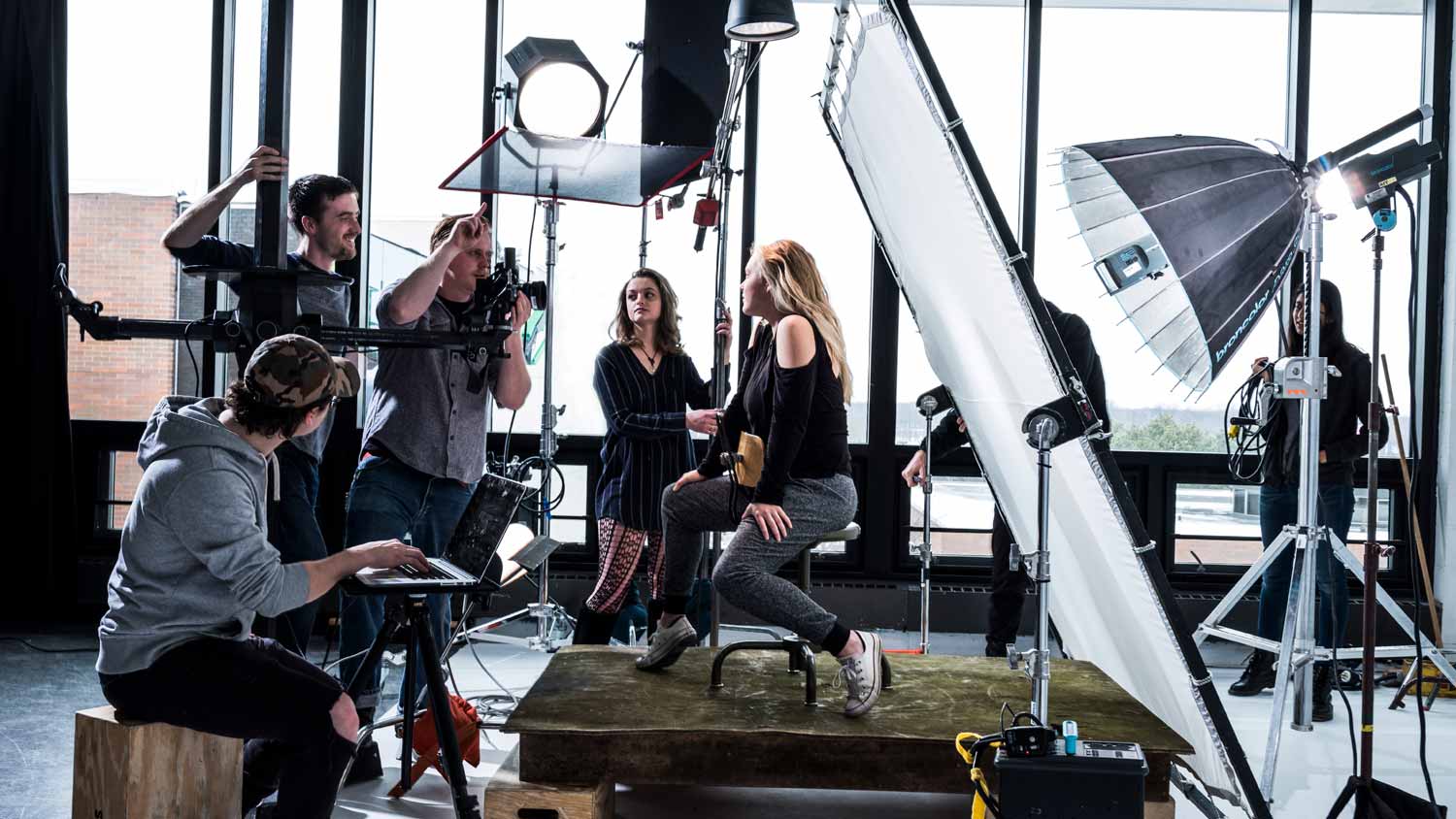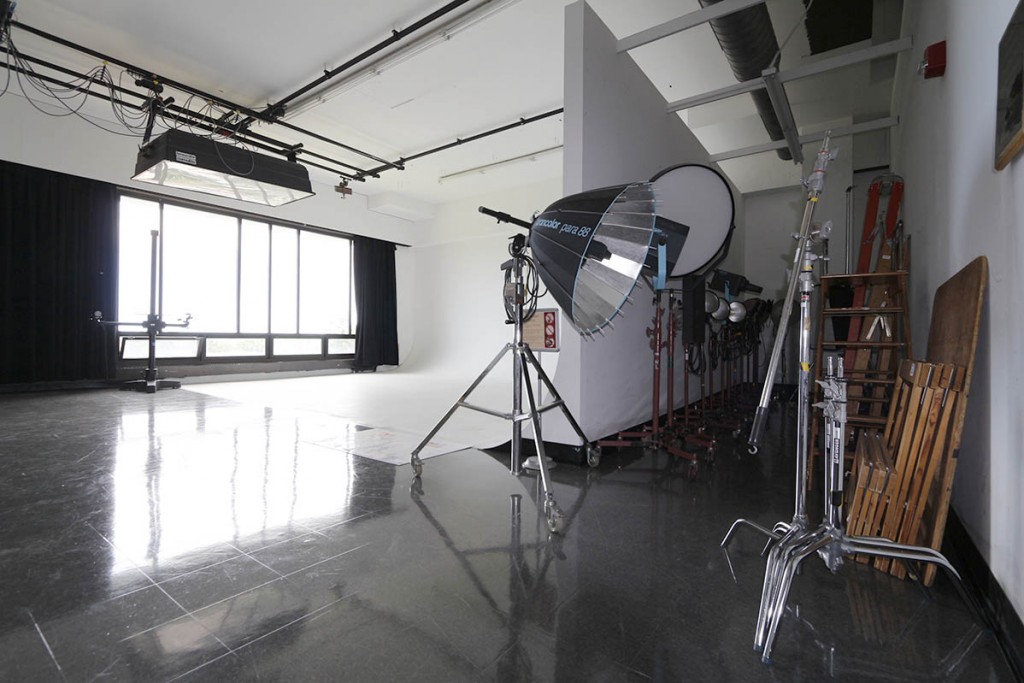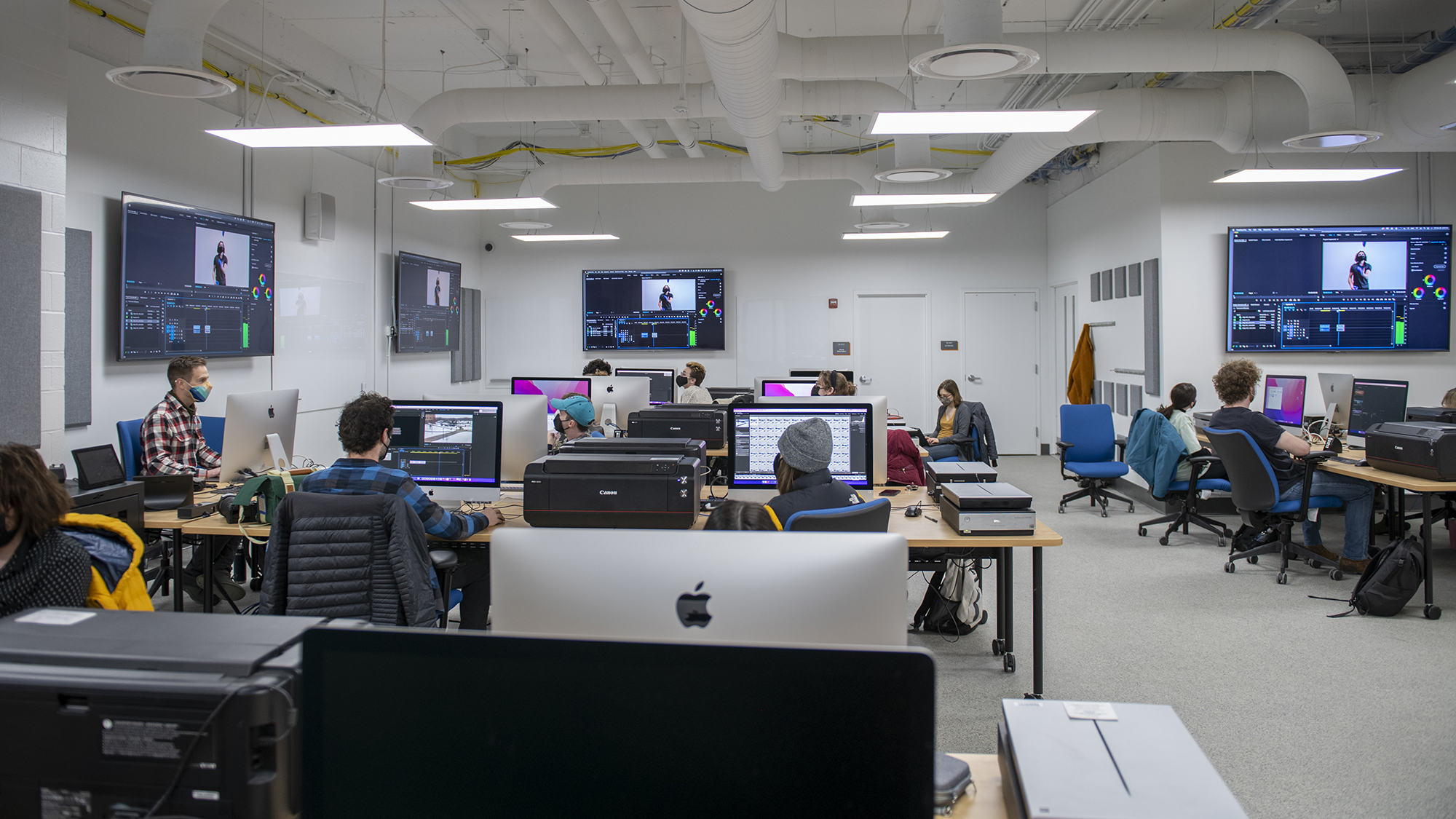Advertising Photography Option - Photographic and Imaging Arts BFA


Advertising Photography Option
Photographic and Imaging Arts BFA
- RIT /
- College of Art and Design /
- Academics /
- Advertising Photography Option - Photographic and Imaging Arts BFA
RIT's BFA in advertising photography prepares you for diverse and rewarding careers in the field of visual communications.
Overview for Advertising Photography Option - Photographic and Imaging Arts BFA
Why Study Advertising Photography at RIT
- Industry Exposure: The School of Photographic Arts and Sciences brings various visiting professionals, events, and talks.
- Gain Real-World Experience: Gain hands-on experience in the classroom and through paid work opportunities like internships and co-op.
RIT’s BFA in commercial photography encourages and nurtures your individual image-making practice, so you can learn to create photographs and moving media for a wide range of commercial use in today’s ever-changing media environment. This option is part of the Photographic and Imaging Arts BFA program.
RIT’s BFA in Advertising Photography
Within the advertising photography BFA you will study the inner workings and business aspects of the photographic and imaging industries. Work collaboratively to conceive and execute camera-based work that is both cutting-edge and strategic. Along with conventional print-based imagery, you may also work in moving media, with emerging and interactive technologies that have real-world applications in the commercial industry.
The commercial photography degree provides flexibility and specialization:
- Advanced courses allow you to explore a variety of commercial specializations from traditional still life and portraiture to interdisciplinary courses.
- Take elective courses from other departments across the university, in majors as diverse as graphic design, visual culture, philosophy, or fine art, in order to enrich your personal visual expression.
- Projects provide opportunities to develop a strong professional portfolio throughout your time in the program as well as real-world team collaborations with other RIT student graphic designers, new media artists, industrial designers, and computer scientists.
- In an ever-growing global market, RIT encourages and offers many study-abroad opportunities.
Next Steps to Enroll
From deposit to housing, view the first five steps for accepted first-year students.
Careers and Experiential Learning
Typical Job Titles
| Advertising Photographer | Architectural Photographer |
| Art Director | Art Producer |
| Artists’ Agent | Editorial Photographer |
| Entrepreneur | Fashion Photographer |
| Food Photographer | Image Retoucher |
| Photo Editor | Portrait Photographer |
| Prop Stylist and Videographer | Sports Photographer |
| Still Life Photographer | Studio Manager |
| Studio Photographer |
Cooperative Education and Internships
What’s different about an RIT education? It’s the career experience you gain by completing cooperative education and internships with top companies in every single industry. You’ll earn more than a degree. You’ll gain real-world career experience that sets you apart.
Co-ops and internships take your knowledge and turn it into know-how. Co-op in the College of Art and Design provides hands-on experience that enables you to apply your artistic capabilities in dynamic professional settings while you make valuable connections between classwork and real-world applications.
Advertising Photography Internships: Students participate in internships with some of the nation’s most respected professional photographers, advertising and design agencies, magazine publishers, photography agents, equipment rental, and production services. Working in a variety of commercial and studio environments, students have the opportunity to learn from photographers, picture editors, art directors, and other professionals. In collaboration with their professors and the Office of Career Services and Cooperative Education, students identify and apply for relevant internships, which provide real-world work experience that becomes an invaluable part of students’ educational experience.
Creative Industry Days
Connect with Design Industry Leaders
RIT’s Office of Career Services and Cooperative Education hosts Creative Industry Days, which connects students majoring in art, design, film and animation, photography, and select computing majors with companies, organizations, creative agencies, design firms, and more. Creative Industry Days are a series of events that allow you to network with company representatives and interview directly for open co-op and full-time employment positions.
Career Opportunities in Advertising Photography
A significant number of graduates become self-employed freelance photographers working all over the country. They also work at advertising agencies and magazines as producers and picture editors. Companies hiring our graduates include Saks Fifth Avenue, Conde Nast Publications, Martha Stewart Living, Neiman Marcus, and many others.
Featured Work
Short Attention Span Film Festival 2023
RIT's Short Attention Span Film Festival is a showcase of moving media projects by students from a variety of majors in the College of Art and Design. Submission include animations (2D, 3D and stop...
Photographing Bills Mafia
Clay Patrick McBride
RIT faculty and students captured the unique pre-game traditions and unbridled passion of Buffalo Bills fans for a story and picture essay featured in Sports Illustrated.
Renowned Editorial and Commercial Photographer
Clay Patrick McBride
Senior Lecturer Clay Patrick McBride is an editorial and commercial photographer celebrated for his portraits of world-class athletes, musicians and celebrities. He has captured portraits of the likes...
Featured Profiles
Why You Belong in RIT's College of Art and Design
Todd Jokl, Mari Jaye Blanchard, Melissa Dawson, Clay Patrick McBride
Get an in-depth look at RIT's College of Art and Design from our faculty and students. Let us share with you how our community of artists pushes the boundaries of creativity and innovation. And...
Industry-standard Photography Equipment
RIT's School of Photographic Arts and Sciences Cage is an unparalleled checkout space housing a range of photography equipment you won’t find anywhere else. From specialty lenses to camera...
Unmatched Photo Studios
With 28 photo studios and a well-stocked equipment cage designed to support studio needs, RIT's School of Photographic Arts and Sciences students have access to all the necessary resources to execute...
Curriculum for 2023-2024 for Advertising Photography Option - Photographic and Imaging Arts BFA
Current Students: See Curriculum Requirements
Photographic and Imaging Arts (advertising photography option), BFA degree, typical course sequence
| Course | Sem. Cr. Hrs. | |
|---|---|---|
| First Year | ||
| ARTH-### | Any 100-level ARTH course (General Education-Artistic Perspective) |
3 |
| ARTH-### | Any 100-level ARTH course (General Education-Global Perspective) |
3 |
| FDTN-111 | Drawing I This course is an introduction to the visualization of form, thought, and expression through the drawing process and is the first of two sequential courses that are the foundation of the drawing curriculum in the College of Art and Design. Concepts are introduced by lectures, discussions, and demonstrations which are designed to provide a broad introductory experience. Students will experiment with a wide variety of media, tools, techniques and subjects to develop drawing and problem-solving skills related to form and composition. The focus of the course is to provide awareness of the full range of ways in which drawing is used as a tool for both self-expression and communication. **Fee: A materials fee is required for this course, and an additional course fee applied via student account** Studio 6 (Fall or Spring). |
3 |
| FDTN-121 | 2D Design I This course is an introduction to the basic elements and principles of two-dimensional design and is foundational to the College of Art and Design curriculum. The focus of this course is the development of visual and verbal vocabularies as a means of exploring and understanding two-dimensional design. Students will engage with a wide variety of media, tools, and techniques to develop skills while delving into the theoretical and experimentational processes of contemporary art and design. The exploration of historical and cultural themes and concepts intertwined with aspects of personal interpretation and experience will be included in the curriculum. **Fee: A materials fee is required for this course, and an additional course fee applied via student account** Studio 6 (Fall or Spring). |
3 |
| PHAR-101 | Photographic Arts I This course will provide an immersive introduction to the field of the photographic arts. It will emphasize both craft and visual problem solving. The course will explore: seeing and appreciating the quality of light, image capture, photographic vision, historical and contemporary genres of photography, best practices and workflow as well as an introduction to the critique forum and its practices. (Co-requisites: PHPS-106 or equivalent course.) Critique 2, Lecture 1, Lab 3 (Fall, Spring). |
4 |
| PHAR-102 | Photographic Arts II This course will reinforce and build upon the skills learned in the first semester of Photographic Arts I. It will emphasize aesthetics, craft, visual problem solving and critical thinking skills - the foundations of the Photographic Arts curriculum. In this semester, the studio will be introduced as a space that can be used to create and control light. This course's curriculum will continue to emphasize both craft and visual problem solving required in high-level photographic imaging. (Prerequisites: PHAR-101 or equivalent course.) Critique 2, Lecture 1, Lab 3 (Fall, Spring). |
4 |
| PHPS-106 | Photographic Technology I (General Education) The course Photographic Science Fundamentals will introduce the application of physics, mathematics, and optical science behind the processes of photography. The course also provides the students with the opportunity to employ statistical data analysis to identify trends through laboratory exercises utilizing principles of scientific inquiry. Lab 3, Lecture 2 (Fall). |
3 |
| PHPS-107 | Photographic Technology II This is the second course in a two-semester course based in the study of the technology of photography, with emphasis on applications to real world photographic problems. Among the topics studied will include color vision, Munsell color system, CIELAB system, color theory, color management, digital color balance during post-processing, digital tone reproduction, and digital workflows. (Prerequisite: PHPS-106 or equivalent course.) Lab 2, Lecture 2 (Spring). |
3 |
| YOPS-10 | RIT 365: RIT Connections RIT 365 students participate in experiential learning opportunities designed to launch them into their career at RIT, support them in making multiple and varied connections across the university, and immerse them in processes of competency development. Students will plan for and reflect on their first-year experiences, receive feedback, and develop a personal plan for future action in order to develop foundational self-awareness and recognize broad-based professional competencies. (This class is restricted to incoming 1st year or global campus students.) Lecture 1 (Fall, Spring). |
0 |
General Education – First-Year Writing (WI) |
3 | |
| Choose one of the following: | 3 |
|
General Education – Natural Science Inquiry Perspective |
||
General Education – Scientific Principles Perspective |
||
General Education – Mathematical Perspective A or B |
||
| Second Year | ||
| FDTN-141 | 4D Design 4D Design introduces students to the basic concepts of art and design in time and space. The course explores elements of moving images such as continuity, still and moving image editing, transitions and syntax, sound and image relations, and principles of movement. Computers, video, photo, sound and lighting equipment are used to create short-form time-based work relevant to students in all majors and programs required to take this course. The course addresses the both historical conventions of time in art and recent technological advances, which are redefining the fields of Fine Art and Design. In focusing on the relations between students' spacing and timing skills, 4D Design extends and supplements the other Foundation courses, and prepares students for further work with time-based media. (Undergraduate Art and Design) Lab 5 (Fall, Spring). |
3 |
| PHAR-202 | Elements of Advertising Photography This course will provide an introduction to the field of commercial photography, as well as encourage students to develop their own artistic vision. Students will create images from assignments that relate to projects they will encounter after graduation. They will be instructed in the basic photographic skills needed in the commercial field. Practical use of exposure metering and digital workflow will be discussed. Training will be provided in the use of professional cameras and lighting equipment, as well as developing a web presence. Portraiture and still life photography will be covered both in the studio and on location. Students will learn about career choices available in the commercial photography business. (Prerequisites: PHPS-102 or PHAR-102 or equivalent course.) Lab 3, Lecture 2 (Fall, Spring, Summer). |
3 |
| PHAR-211 | Histories and Aesthetics of Photography I (General Education) This course presents an overview of the multiple, intersecting histories and aesthetic practices of photography between 1800 and 1915 and its applications in fine art, snapshot, documentary, scientific, commercial, and propaganda in a global perspective. Course lectures include the medium’s pre-history and the development of photography as a modern art form. Students will learn about different photographic processes as well as the multiple interpretations of notable images from the era, and will analyze connections between science, culture, history, and photography. Lecture 3 (Fall or Spring). |
3 |
| PHAR-212 | Histories and Aesthetics of Photography II The objective of this course, the second course of a two-semester sequence, is to present an overview of the multiple, intersecting histories and aesthetic practices of photography from the development of Modernism to the present, including the medium's transformation by digital imaging in the 21st century. Photography's applications within fine art, documentary, scientific, journalistic, commercial and vernacular practices will be investigated within a global perspective, but primary emphasis is placed upon developments and movements within the United States and Europe. Lecture 3 (Spring, Summer). |
3 |
| Choose one of the following: | 3 |
|
| PHAR-201 | Elements of Fine Art Photography This course will offer students an introduction to the discipline of fine art photography. Conceptually driven projects will be investigated through a variety of photographic techniques; reading, writing and discussion about the intent and meaning of photographic imagery will be emphasized. Aspects of still photography and moving imagery as artistic choices and practices will be presented. The goal of the course is to establish theoretical, aesthetic and technical strategies for the production of photographic artwork. If you are pursing the Fine Art Photography option this course is required. (Prerequisites: PHPS-102 or PHAR-102 or PHAR-161 or equivalent course.) Lab 3, Lecture 2 (Fall, Spring, Summer). |
|
| PHAR-203 | Elements of Photojournalism This course will serve as an introduction to visual story telling as it relates to professional photojournalism. It will provide relevant practice in basic technical, compositional, and interpersonal skills necessary in all aspects of modern photography. Students will be exposed to photojournalism - documentary, editorial, narrative, and editing - as well as explorations of current career possibilities. Lectures, critiques, demonstrations, and assignments will provide participants the opportunity to explore the still, audio, and multimedia strategies used for storytelling. In this course students are expected to meet real-world project deadlines and participate in class discussions and critiques. (Prerequisites: PHAR-102 or PHAR-161 or PHPS-102 or equivalent course or students in the JOURNAL-BS program.) Lab 3, Lecture 2 (Fall, Spring). |
|
| PHAR-204 | Elements of Visual Media This course will provide an introduction to the professional opportunities where the fields of photography, graphic design and print media overlap. Students will develop an understanding of the working relationships between professionals involved in each of the three career areas. Successful visual media experts require a contemporary understanding of the business practices necessary to manage the workflow, financial operations and personnel necessary for success. Students in this class will experience the breadth of interactions between these three career paths, and appreciate the management necessary in their dynamic relationships. Students pursing the Visual Media option are required to take this course. (Prerequisites: PHPS-102 or PHAR-102 or PHAR-161 or equivalent course.) Lecture 3 (Fall, Spring, Summer). |
|
General Education – Social Perspective |
3 | |
General Education – Ethical Perspective |
3 | |
CAD Elective |
3 | |
Open Electives |
6 | |
| Third Year | ||
| PHAP-241 | Advanced Video for Photographers |
3 |
| PHAP-301 | Advertising Photography I This is the first of a sequence of required advertising photography courses that investigates visual problem solving when applied to commercial photography. Studio and other controlled environments will be encountered through assignments. Advertising and editorial solutions and applications will be explored. The skills necessary to photograph people, places, and things will be learned through various assignments. (Prerequisites: PHAR-202 and (PHAR-201 or PHAR-203 or PHAR-204) or equivalent courses.) Lab 3, Lecture 2 (Fall). |
3 |
| PHAP-302 | Advertising Photography II Building on the content delivered in Advertising Photography I, Advertising Photography II will introduce business aspects involved in commercial photography. Students will create self-promotion materials as well as a resume/cover letter. A cohesive portfolio is required at the end of the course. Students will also work on a group project, introducing them to the collaborative nature of the advertising business. Assignments will emphasize conceptual over technical solutions. (Prerequisites: PHAP-301 or equivalent course.) Lab 3, Lecture 2 (Spring). |
3 |
| PHAP-361 | Retouch and Restore This course will explore the techniques, tools, practices, and workflows used in retouching industry practices. This course will begin with basic masking, skin retouching, and compositing techniques then apply these skills to creating images. The importance of the collaborative role of the image-maker and the retouch technician will be discussed throughout the course. The primary goals of this course are to teach students how to craft a personal or signature imaging style, and understand retouching as an important skillset for image makers. (Prerequisites: PHAR-201 or PHAR-202 or PHAR-203 or PHAR-204 or equivalent course.) Lab 5 (Fall or Spring). |
3 |
Advertising Photography Professional Electives‡ |
6 | |
CAD Elective§ |
3 | |
General Education – Immersion 1 (WI-GE), 2 |
6 | |
Open Elective |
3 | |
| Fourth Year | ||
| PHAP-403 | Portfolio Development (WI-PR) This course is required for advertising photography students who are approaching graduation and are preparing to present themselves to potential employers. Students will narrow their field of interests to focus their work for an end-of-study portfolio. Existing and new work will be edited, sequenced and prepared to form a professional quality portfolio, promotional materials, a resume/cover letter, a market research paper and a business plan. (Prerequisites: PHAP-302 or equivalent course and completion of First Year Writing (FYW) requirement.) Lecture 3 (Spring). |
3 |
| Choose one of the following: | 3 |
|
| FINC-120 | Personal Financial Management Examines financial decisions people must make in their personal lives. Covers personal taxation, housing and mortgages, consumer credit, insurance (including life, health, property and casualty), and retirement and estate planning. Also reviews the common financial investments made by individuals, including stocks, bonds, money market instruments and mutual funds. This class involves extensive use of the internet for access to information. (Students in the Finance Program may use this course only as a free elective, not as a course creditable towards the Finance Program.) (This course is available to RIT degree-seeking undergraduate students.) Lecture 3 (Fall, Spring, Summer). |
|
| MGMT-150 | Business 1T: An Introduction to Business Designed as an introductory business course for students in the Saunders College that want to learn more about the fundamentals of business. This course provides an overview of the functions and processes of business organizations. Topics include the role and responsibility of the manager, the processes and functions of business, the impact of technology, business planning process, doing business in global environments, and career exploration. NOTE: Students may not take MGMT 150 if they have already taken MGMT 101 and MGMT 102. (Students may not take MGMT-150 if they have already taken MGMT-101 and MGMT-102.) Lecture 3 (Fall, Spring). |
|
| MGMT-215 | Organizational Behavior As an introductory course in managing and leading organizations, this course provides an overview of human behavior in organizations at the individual, group, and organizational level with an emphasis on enhancing organizational effectiveness. Topics include: individual differences, work teams, motivation, communication, leadership, conflict resolution, organizational culture, and organizational change. (This class is restricted to undergraduate students with at least 2nd year standing.) Lecture 3 (Fall, Spring, Summer). |
|
| MKTG-230 | Principles of Marketing An introduction to the field of marketing, stressing its role in the organization and society. Emphasis is on determining customer needs and wants and how the marketer can satisfy those needs through the controllable marketing variables of product, price, promotion and distribution. (This class is restricted to undergraduate students with at least 2nd year standing.) Lecture 3 (Fall, Spring, Summer). |
|
| PHAP-321 | Industry Practices for Professional Photographers Industry Practices for Professional Photographers, will provide advertising photography students with an in- depth understanding of the practices and principles of the photographic business world. Through lectures (which include guest speakers), the class will cover entry-level jobs, licensing/copyright, estimating/pricing, insurance, taxes, the breadth of industry jobs and marketing a small business. Also included will be interviewing strategies and implementing changes in career paths for students interested in pursuing a career in advertising photography. (Prerequisites: PHAP-302 or equivalent course.) Lecture 3 (Fall). |
|
CAD Electives§ |
9 | |
Open Elective |
6 | |
General Education – Immersion 3 |
3 | |
Advertising Photography Professional Elective‡ |
6 | |
| Total Semester Credit Hours | 122 |
|
Please see General Education Curriculum (GE) for more information.
(WI) Refers to a writing intensive course within the major.
Please see Wellness Education Requirement for more information. Students completing bachelor's degrees are required to complete two different Wellness courses.
† Please consult an adviser for a complete list of courses that fulfill the advertising specialization requirement.
‡ Please consult an adviser for a complete list of courses that fulfill the professional elective requirement.
§ CAD elective refers to any course in the College Art and Design.
** Please consult an advisor for a complete list of imaging core courses.
Admissions and Financial Aid
This option is part of the Photographic and Imaging Arts BFA. Please visit the degree program page for admission requirements.
Financial Aid and Scholarships
100% of all incoming first-year and transfer students receive aid.
RIT’s personalized and comprehensive financial aid program includes scholarships, grants, loans, and campus employment programs. When all these are put to work, your actual cost may be much lower than the published estimated cost of attendance.
Learn more about financial aid and scholarships
Latest News
-
April 8, 2024
![Student Kristy Sorochan operates an 11x14 large format camera during the eclipse.]()
Students capture dramatic midday twilight during eclipse totality
College of Art and Design students were out in force documenting the rare total solar eclipse seen in Rochester, N.Y., and other parts of the country.
-
March 25, 2024
![A portrait of a noble figure with the words Sinfully Brilliant.]()
Photography-design duo captures advertising award for perfume campaign
The photography of Kyra Allen '24 and art direction, layout and copywriting of Char Miller '24 netted the duo a silver American Advertising Award from the Rochester Advertising Federation.
-
March 21, 2024
![A student binds a book in the textile makerspace in the SHED.]()
Innovation unleashed: students forge transdisciplinary projects at RIT's a2ru summit
Students leveraged the variety of makerspaces in RIT's brand-new SHED facility to create arts-integrative work responding to a theme of "Play."



















